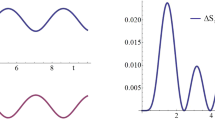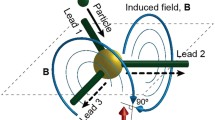Abstract
The physical process of observation is considered from a specific information theoretical viewpoint. Using the modified concept of an information based on infinite alternatives, a formalism is derived describing the elementary transfer of one bit of information. This bit of information is produced on a virtual (nonreal) sub-quantum level of physical description. The interpretation of the formalism yields the following, complementary points: (i) the effect of spatiotemporal delocalization on the sub-quantum level, and (ii) a possible access to the concept of chaos as an intrinsic property of quantum systems. As a brief example, elementary information transfer is illustrated in a cosmological context. Finally, a formal approach to information production on the sub-quantum level is sketched on the basis of complex time.
Similar content being viewed by others
References
F. W. Kantor,Information Mechanics (Wiley, New York, 1977).
C. E. Shannon and C. Weaver,The Mathematical Theory of Communication (University of Illinois Press, Urbana, 1962).
L. Brillouin,Science and Information Theory (Academic, New York, 1967).
A. Kaufmann,Introduction to the Theory of Fuzzy Subsets, Vol. 1 (Academic, New York, 1975).
J. F. Cyranski,Found. Phys. 9, 641 (1979).
J. F. Cyranski,J. Math. Phys. 22, 1467 (1981).
S. T. Ali and E. Prugovečki,J. Math. Phys. 18, 219 (1977), and references therein.
V. Majernik,Acta Phys. Aust. 25, 243 (1967).
C. F. von Weizsäcker,Aufbau der Physik (Hanser, München, 1985).
R. Shaw,Z. Naturforsch. 36a, 80 (1981).
J. D. Farmer,Z. Naturforsch. 37a, 1304 (1982).
J.-P. Eckmann and D. Ruelle,Rev. Mod. Phys. 57, 617 (1985).
I. Procaccia,Phys. Scr. T9, 40 (1985).
H. Atmanspacher and H. Scheingraber,Found. Phys. 17, 939 (1987), and further references therein.
S. Goldstein,Israel J. Math. 38, 241 (1981).
P. C. W. Davies,The Physics of Time Asymmetry (Surrey University Press, Guildford, 1974).
J. S. Bell,Rev. Mod. Phys. 38, 447 (1966).
H. P. Stapp,Phys. Rev. D3, 1303 (1971).
E. T. Jaynes,Phys. Rev. 106, 620 (1957).
I. Prigogine,From Being to Becoming, 2nd edn. (Freeman, San Francisco, 1980).
B. Misra, I. Prigogine, and M. Courbage,Physica 98A, 1 (1979).
Y. Elskens and I. Prigogine,Proc. Natl. Acad. Sci. USA 83, 5756 (1986).
G. Mayer-Kress, ed.,Dimensions and Entropies in Chaotic Systems (Springer, Berlin, 1986).
K. Tomita,Found. Phys. 17, 699 (1987).
B. Ya Zel'dovich and D. D. Sokolov,Sov. Phys. Usp. 28, 608 (1985) (Usp. Fiz. Nauk. 146, 493 (1985)).
E. Nelson,Phys. Rev. 150, 1079 (1966).
P. A. M. Dirac,Nature 168, 906 (1951),Nature 169, 702 (1952).
M. Toda and S. Adachi, inDynamical Systems and Singular Phenomena (World Scientific, Singapore, 1987), p. 1.
M. Toda and K. Ikeda,J. Phys. A20, 3833 (1987).
M. Toda and K. Ikeda,Phys. Lett. 124A, 165 (1987).
M. Jammer,The Philosophy of Quantum Mechanics (Wiley, New York, 1974).
I. Prigogine and T. Y. Petrofsky,Physica 147A, 33 (1987);147A, 461 (1988).
J. A. Wheeler, inFoundational Problems in the Special Sciences, R. E. Butts and J. Hintikka, eds. (Reidel, Dordrecht, 1977), p. 3; inThe Nature of Scientific Discovery, O. Gingerich, ed. (Smithsonian Press, Washington, 1975), pp. 261–296 and pp. 575–587. See also J. D. Barrow and F. J. Tipler,The Anthropic Cosmological Principle (Clarendon Press, Oxford, 1986).
P. H. Damgaard and H. Hüffel,Phys. Rep. 152, 385 (1987).
W. Mückenheim,Phys. Rep. 133, 337 (1986).
L. P. Hughston,Twistor Newsletter 18, 33 (1984).
G. M. Zaslavsky,Phys. Rep. 80, 157 (1981).
M. V. Berry,Proc. R. Soc. Lond. A413, 183 (1987).
Author information
Authors and Affiliations
Rights and permissions
About this article
Cite this article
Atmanspacher, H. The aspect of information production in the process of observation. Found Phys 19, 553–577 (1989). https://doi.org/10.1007/BF00734660
Received:
Revised:
Issue Date:
DOI: https://doi.org/10.1007/BF00734660




